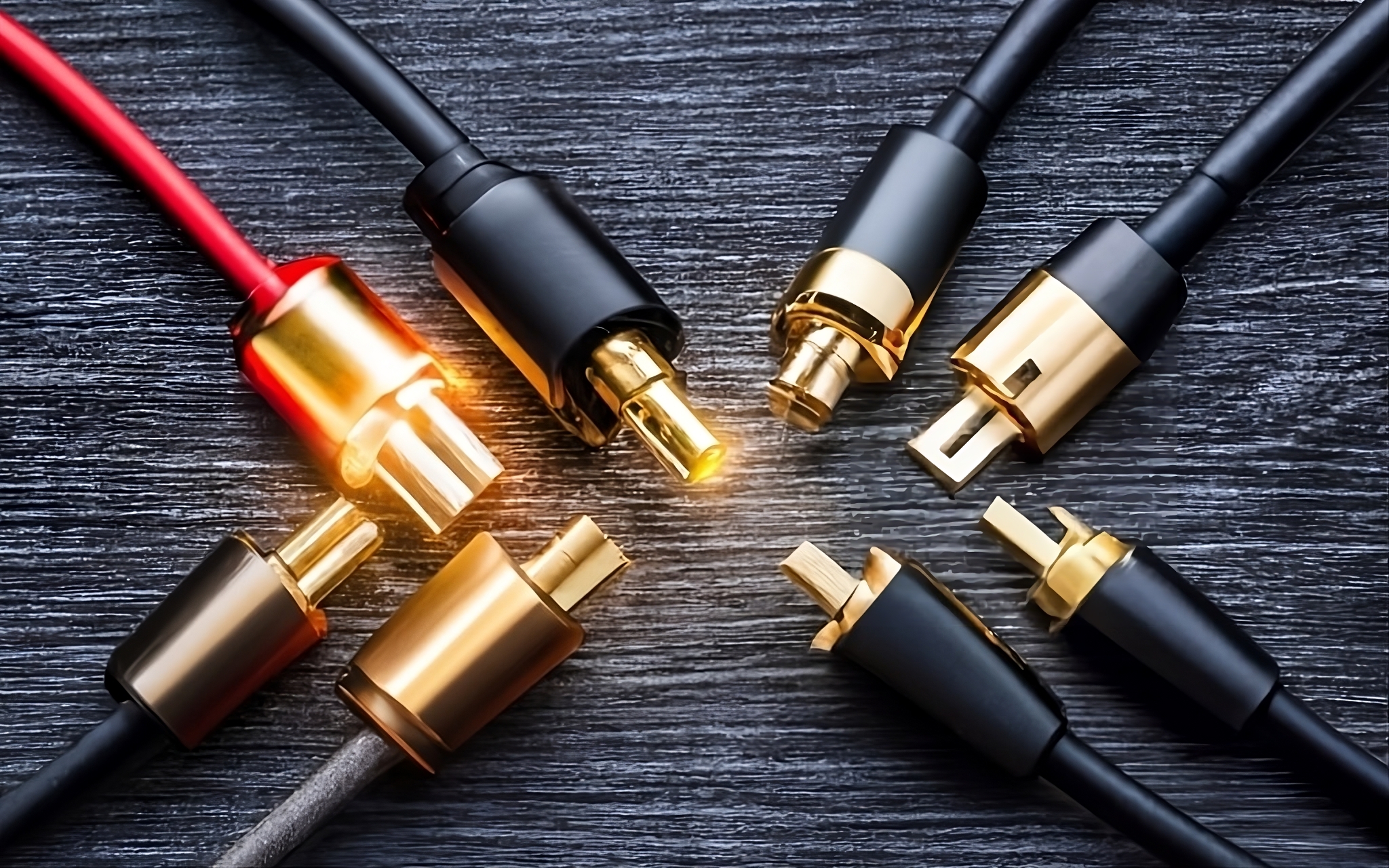Introduction
A Symphony of Sound: Unveiling the Mysteries of Audio Cables
Ah, the world of audio cables! It’s a labyrinth of tangled wires, connectors, and countless technical terms.
But fear not, dear readers, for today we embark on a journey to demystify this enigmatic realm. Whether you’re an audiophile, a casual music lover, or simply someone curious about the intricacies of sound transmission, understanding the differences between digital and analog audio cables is crucial.
Now, let’s take a moment to grasp the essence of audio cables. At its core, an audio cable is a conduit that carries electrical signals from one device to another.
It serves as the messenger between your treasured music collection and your speakers or headphones. These cables are responsible for preserving the fidelity and integrity of sound as it travels through various components in your setup.
A Sonic Tapestry: The Intricate Web of Audio Cables
To truly appreciate the significance of digital versus analog audio cables, we must first recognize their fundamental categories – digital and analog. Analog cables transmit continuous electrical signals that mirror the original sound waveform. They have been around since the early days of audio technology and have evolved into various forms like RCA (Radio Corporation of America) connectors or XLR (eXtended Linearity Range) cables.
On the other hand, digital cables carry discrete numerical representations of sound known as binary code. They rely on precise 0s and 1s to convey information accurately.
HDMI (High-Definition Multimedia Interface), optical (TOSLINK), or coaxial (SPDIF) connectors are typical examples in this domain. Understanding these two distinct types is vital because they traverse different paths in our ever-evolving sonic landscape.
But why does understanding these differences matter? Well, my curious friends, knowing whether to opt for digital or analog audio cables can significantly impact the quality of your audio experience.
It determines the level of detail, fidelity, and overall sonic richness that reaches your ears. So, join me as we venture forth into the intricacies of these two realms, unlocking the secrets behind their unique characteristics and uncovering how they shape our auditory delights.
Digital Audio Cables
Definition and Purpose of Digital Audio Cables
Digital audio cables are designed to transmit audio signals in a digital format, where the sound is converted into a series of 1s and 0s. Unlike analog cables that transmit continuous electrical signals, digital cables carry a stream of discrete digital data.
The purpose of digital audio cables is to deliver high-fidelity sound reproduction, allowing for clear and accurate transmission of audio files or streams. Digital audio cables are commonly used in various entertainment systems, home theaters, professional studios, and modern audio equipment.
They facilitate the seamless transmission of multi-channel surround sound formats like Dolby TrueHD or DTS-HD Master Audio, ensuring an immersive listening experience. By converting analog signals into digital ones, these cables enable precise signal reproduction without significant interference or degradation.
Types of Digital Audio Cables
There are several types of digital audio cables available in the market today. Let’s take a closer look at three popular options:
HDMI: The High-Definition Multimedia Interface (HDMI) cable has become ubiquitous with modern home theaters and multimedia setups. HDMI carries both high-quality video and audio signals digitally using a single cable connection.
It supports various formats such as PCM (Pulse Code Modulation), Dolby Digital Plus, DTS-HD Master Audio, and more. This versatility makes HDMI the go-to choice for connecting devices such as Blu-ray players, gaming consoles, AV receivers, and televisions.
Optical: Optical audio cables use light signals to transmit digital audio data from one device to another. They utilize fiber-optic technology that allows for high-fidelity sound transmission with minimal interference from electromagnetic fields or radio frequency interference (RFI).
This makes optical cables ideal for connecting devices where electrical noise might be present or when long-distance transmission is required. Commonly found on devices like soundbars, DVD players, and audio interfaces, optical cables provide exceptional audio quality and reliable data transfer.
Coaxial: Coaxial digital audio cables use electrical signals to transmit digital audio data. They employ a coaxial conductor arrangement, where the signal-carrying center conductor is surrounded by a shield that minimizes interference from external sources.
Coaxial cables offer a cost-effective solution for digital audio transmission and are commonly used in professional audio setups, gaming consoles, and digital audio interfaces. While not as immune to interference as optical cables, coaxial connections still provide reliable transmission over moderate distances.
Understanding the differences between digital and analog audio cables is crucial in achieving optimal sound quality in any setup. Digital audio cables offer superior fidelity by converting analog signals into precise digital data streams.
HDMI, optical, and coaxial are three common types of digital cables that cater to various needs based on their specific transmission methods and capabilities. By selecting the right type of cable for your requirements, you can ensure an enhanced auditory experience without compromising signal integrity or succumbing to unwanted noise or interference.
Analog Audio Cables
Definition and Purpose of Analog Audio Cables
Analog audio cables have been the backbone of audio connections for decades, serving as the traditional means of transmitting sound signals. Unlike digital audio cables, which convert sound into a series of 0s and 1s, analog cables transmit continuous electrical signals representing audio waveforms.
This analog nature allows for a more direct representation of the original sound, capturing nuances that digital conversion may miss. The purpose of analog audio cables is to transfer these electrical signals from one device to another accurately, ensuring faithful reproduction of the original sound.
Types of Analog Audio Cables (e.g., RCA, XLR, TRS)
When it comes to analog audio cables, several types are commonly used in different settings. Let’s explore three prominent examples:
1. RCA: – RCA (Radio Corporation of America) cables are widely recognized in consumer-grade audio equipment due to their simplicity and ubiquity.
These cables consist of two connectors with a characteristic red and white color-coding for left and right channels respectively. – While RCA cables are readily available and easy to use, they are primarily designed for lower fidelity applications such as home stereo systems or consumer-grade recording setups.
2. XLR: – XLR (eXternal Line Return) cables are widely regarded as professional-grade balanced audio connectors used extensively in studio environments.
– These robust three-pin connectors provide superior noise rejection capabilities thanks to their balanced design. – By employing a positive signal wire (pin 2), negative signal wire (pin 3), and ground wire (pin 1), XLR connectors minimize interference and maximize signal quality during long cable runs.
– Commonly found on microphones, mixers, amplifiers, and high-end speakers or headphones. 3. TRS:
– TRS (Tip-Ring-Sleeve) connectors, also known as 1/4″ audio jacks, are versatile analog audio cables used for both balanced and unbalanced connections. – These connectors consist of three sections: tip, ring, and sleeve.
The tip carries the left channel signal, the ring carries the right channel signal or a return signal for balanced connections, and the sleeve serves as the common ground connection. – TRS cables are commonly found in various applications, including musical instruments like guitars and keyboards, headphone outputs on audio interfaces or mixers, and professional audio equipment.
Signal Transmission Differences
Digital Audio Cables:
Transmission method:
Digital audio cables, such as HDMI, optical, and coaxial, rely on the transmission of uncompressed Pulse Code Modulation (PCM) or encoded data streams transmitted as discrete bits. PCM is a method of digitally representing analog audio signals by sampling the signal at regular intervals and converting it into binary code. This ensures accurate reproduction of the original sound wave, resulting in high fidelity audio.
Moreover, digital audio cables have the capability to carry multi-channel surround sound formats like Dolby TrueHD or DTS-HD Master Audio. These formats allow for an immersive audio experience with precise positioning of sound elements and enhanced clarity.
Noise resistance:
Digital signals are inherently less susceptible to noise interference compared to analog signals due to their error correction mechanisms. When a digital signal undergoes transmission, it is accompanied by error correction codes that detect and correct any potential errors caused by noise or distortion during transit.
This robustness ensures that the integrity of the digital audio data remains intact even in noisy environments. In addition to their resistance to noise interference, digital audio cables also exhibit minimal signal degradation over long distances.
Unlike analog cables that may suffer from signal loss due to attenuation over extended lengths, digital signals remain largely unaffected by distance. This makes them suitable for applications where long cable runs are necessary without compromising quality.
Conclusion
Understanding the differences between digital and analog audio cables is crucial for anyone seeking optimal audio quality in their setups. Digital audio cables offer numerous advantages when it comes to signal transmission. They employ advanced techniques such as PCM encoding and error correction mechanisms, ensuring accurate reproduction of sound while minimizing potential disruptions caused by external factors like noise and distance.
With the ability to support high-quality surround sound formats, digital audio cables provide an immersive audio experience that enhances the overall enjoyment of music, movies, and other multimedia content. So, whether you’re assembling a home theater system or setting up a professional studio, opting for digital audio cables can significantly elevate your audio experience.
Embrace the advantages they bring and revel in the astonishing fidelity and clarity that digital transmission provides. Your ears will relish the intricate details and nuances delivered by these modern marvels of connectivity.
 Skip to main content
Skip to main content


